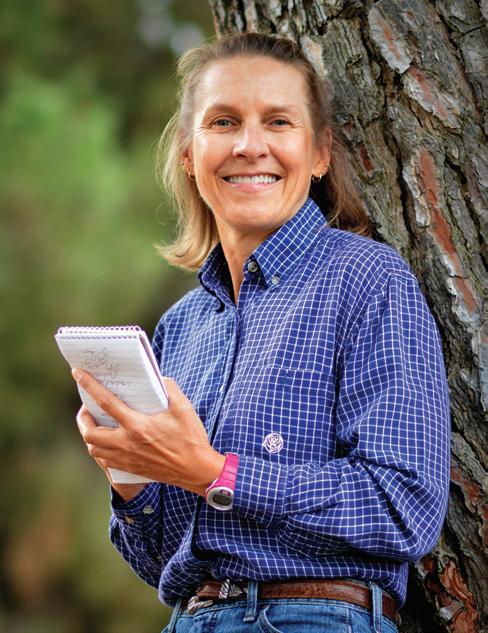
3 minute read
From the Editor4 From the Editor
Still flying after 100 years
Crop dusting had its roots in 1921 when Lt. John A. Macready piloted a modified Curtis JN-6 Super Jenny while passenger Etienne Dormoy dispensed lead arsenate from a crude metal hand-cranked hopper bolted to the plane’s fuselage. C.R. Nellie, an Ohio Department of Agriculture entomologist, had come up with the idea for crop dusting to control sphinx moth larvae in catalpa trees.
Little did the skeptics at the time realize but aerial application would only grow in importance and a century later is vital to farmers and foresters. In no other crop is it more crucial than in rice, where ag pilots do everything from fly- Vicky Boyd ing seed into water-seeded systems to applying Editor crop protection materials and harvest aids to planting subsequent cover crops by air.
“Nearly any industry that has survived for 100 years has had to evolve, and we’ve had to do a better job,” said Mark Kimmel, owner of Dixie Dusters near Itta Bena, Mississippi, and president of the National Agricultural Aviation Association. “We’re professional pilots, and we have training that we have to go through every year, educational updates, continuing education units. And we’ve invested in our planes with GPS for precision ag.”
Of all the technological advances in ag aviation, Kimmel said GPS has been one of the most impactful. He cut his teeth in the business as a flagger for his father, who also was an ag pilot. Moving flagging crews from field to field slowed down application, and flagging could be less than accurate.
Once he earned his pilot’s wings, Kimmel recalled having to manually plot out passes across a field to determine how much product to load. He didn’t want to run out in the middle of a pass.
As a result, pilots didn’t necessarily carry full loads and spent more time and fuel ferrying product.
“When they came out with GPS for our airplanes, we thought it was too expensive,” he said. “Then we did it, and it was just amazing how much more productive we were. It was like wow! Look at this.”
With GPS, pilots can carry full loads. If they run out in the middle of a pass, they can pick up exactly where they left off.
A GPS light bar mounted on the top of the airplane hood allows pilots to line up each pass, minimizing skips and overlaps. A laser altimeter tells them if they’re at the optimal application height of 15 to 18 feet above the plant canopy. Between GPS and precision application technology, pilots also are able to provide variable-rate application to growers.
What technology is in store for the next century of agricultural aviation? In the not too distant future, Kimmel said pilots will have in-cab weather stations that provide real-time information, such as wind speed and direction, temperature and relative humidity. If conditions change midway through an application, the pilot will be able to quickly make corrections.
Vicky
EDITORIAL/PRODUCTION
Editor Vicky Boyd 209-505-3612 vlboyd@onegrower.com
Copy Editor Amanda Huber ahuber@onegrower.com
Art Director Ashley Kumpe akumpe@onegrower.com
ADMINISTRATION
Publisher/Vice President Lia Guthrie 901-497-3689 lguthrie@onegrower.com
Associate Publisher Carroll Smith 901-326-4443 csmith@onegrower.com
Sales Manager Scott Emerson 386-462-1532 semerson@onegrower.com
Production Manager Kathy Killingsworth 901-767-4020 kkillingsworth@onegrower.com
Audience Services Kate Thomas 847-559-7514
For subscription changes or change of address, call 847-559-7578 or email ricefarming@omeda.com
ONE GROWER
PUBLISHING, LLC
Mike Lamensdorf President/Treasurer Lia Guthrie Publisher/Vice President
ASSOCIATED PUBLICATIONS — One Grower Publishing LLC also publishes COTTON FARMING, THE PEANUT GROWER, SOYBEAN SOUTH and CORN SOUTH magazines. RICE FARMING (ISSN 0194-0929) is published monthly January through May, and Decem ber, by One Grower Publishing LLC, 875 W. Poplar Ave., Suite 23, Box 305, Collierville, TN 38017. Period icals postage paid at Memphis, Tennesee, and at additional mailing offices. POSTMASTER: Send address changes to
OMEDA COMMUNICATIONS, CUSTOMER SERVICE DEPARTMENT, P.O. BOX 1388, NORTHBROOK,
IL 60065-1388. Annual subscriptions are $25.00. International rates are $55.00 Canada/Mexico, $90.00 all other countries for Air-Speeded Delivery. (Surface delivery not available due to problems in reliability.) $5.00 single copy.
All statements, including product claims, are those of the person or organization making the statement or claim. The publisher does not adopt any such statement or claims as its own and any such statement or claim does not necessarily reflect the opinion of the publisher. RICE FARMING is a registered trademark of One Grower Publishing LLC, which reserves all rights granted by the U.S. Patent and Trademark Office in association with its registration.
© Copyright 2021








